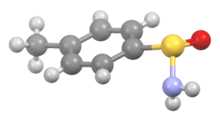
In organosulfur chemistry, sulfinamide is a functional group with the structure R−S(=O)−NR2 (where R = alkyl or aryl).[1] This functionality is composed of a sulfur-carbon (S−C) and sulfur-nitrogen (S−N) single bonds, as well as a sulfur-oxygen double bond (S=O), resulting in a tetravalent sulfur centre (in resonance with its zwitterionic form). As a non-bonding electron pair is also present on the sulfur, these compounds are also chiral. They are sometimes referred to as S-chiral sulfinamides. Sulfinamides are amides of sulfinic acid (R−S(O)OH).
Structure
[edit]
Sulfinamides do not undergo inversion. They can therefore be synthesised and/or isolated in enantiopure forms. This has led to their use as chiral ammonia equivalents and more broadly as chiral auxiliaries.
Synthesis
[edit]Sulfinamides are traditionally produced by the reaction of sulfinyl chlorides with primary or secondary amines.[1] They also arise by the addition of Grignard reagents to sulfinylamines, followed by protonation:
- RMgX + R'N=S=O → RS(O)(NR'MgX)
- RS(O)(NR'MgX) + H2O → RS(O)(NR'H) + "MgX(OH)"
Yet another route entails peracid-oxidation of sulfenylphthalimides, which gives sulfinylphthalimides.
Examples
[edit]A common sulfinamide is tert-butanesulfinamide (Ellman's sulfinamide), p-toluenesulfinamide (Davis' sulfinamide), and 2,4,6-trimethylbenzenesulfinamide.[3][4][5]
Sulfinamides arise in nature by the addition of nitroxyl (HNO) to thiols:[6]
- RSH + HNO → RS(O)NH2
References
[edit]- ^ a b J. G. Tillett (1981). "Sulphinamides". In Saul Patai (ed.). Sulphinic Acids, Esters and Derivatives. PATAI'S Chemistry of Functional Groups. John Wiley & Sons. pp. 185–215. doi:10.1002/9780470772270.ch7. ISBN 978-0-471-91918-6.
- ^ Eccles, K. S.; Morrison, R. E.; Daly, C. A.; O'Mahony, G. E.; Maguire, A. R.; Lawrence, S. E. (2013). "Co-crystallisation Through Halogen Bonding with Racemic or Enantiopure Sulfinamides". CrystEngComm. 15 (37): 7571–7575. doi:10.1039/C3CE40932E.
- ^ Fanelli, D. L.; Szewczyk, J. M.; Zhang, Y.; Reddy, G. V.; Burns, D. M.; Davis, F. A. (2000). "SULFINIMINES (THIOOXIMINE S-OXIDES): ASYMMETRIC SYNTHESIS OF METHYL (R)-(+)-β-PHENYLALANATE FROM (S)-(+)-N-(BENZYLIDENE)-p-TOLUENESULFINAMIDE". Organic Syntheses. 77: 50
{{cite journal}}: CS1 maint: multiple names: authors list (link); Collected Volumes, vol. 10, p. 47. - ^ Ruano, J. L.; Alemán, J.; Parra, A.; Cid, M. B. (2007). "PREPARATION OF N-p-TOLYLSULFONYL-(E)-1-PHENYLETHYLIDENEIMINE". Organic Syntheses. 84: 129
{{cite journal}}: CS1 maint: multiple names: authors list (link). - ^ Ramachandar, T.; Wu, Y.; Zhang, J.; Franklin A. Davis (2006). "(S)-(+)-2,4,6-TRIMETHYLBENZENESULFINAMIDE". Organic Syntheses. 83: 131
{{cite journal}}: CS1 maint: multiple names: authors list (link). - ^ Keceli, Gizem; Toscano, John P. (2014-06-10). "Reactivity of C-Terminal Cysteines with HNO". Biochemistry. 53 (22): 3689–3698. doi:10.1021/bi500360x. ISSN 0006-2960. PMID 24869490.
Well, that’s interesting to know that Psilotum nudum are known as whisk ferns. Psilotum nudum is the commoner species of the two. While the P. flaccidum is a rare species and is found in the tropical islands. Both the species are usually epiphytic in habit and grow upon tree ferns. These species may also be terrestrial and grow in humus or in the crevices of the rocks.
View the detailed Guide of Psilotum nudum: Detailed Study Of Psilotum Nudum (Whisk Fern), Classification, Anatomy, Reproduction